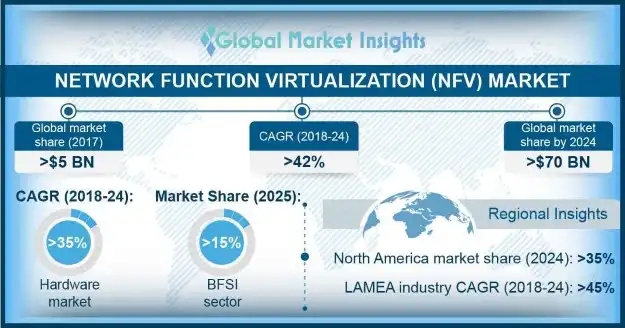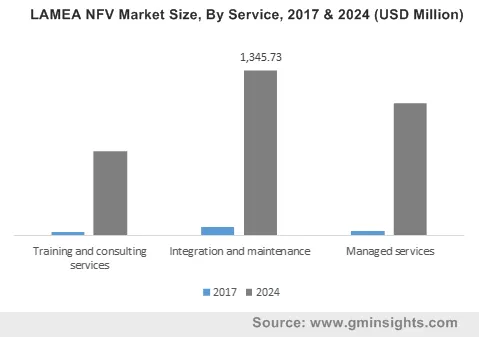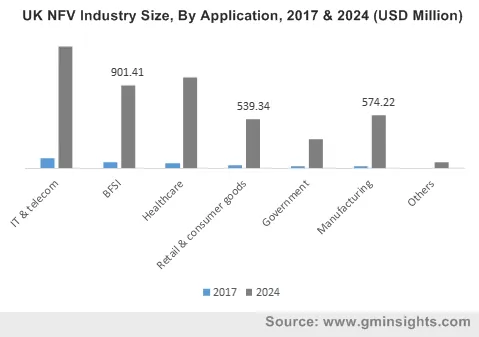


Network Function Virtualization (NFV) Market
Get a free sample of this report
Your inquiry has been received. Our team will reach out to you with the required details via email. To ensure that you don't miss their response, kindly remember to check your spam folder as well!
Form submitted successfully!
Error submitting form. Please try again.

Request Sectional Data
Your inquiry has been received. Our team will reach out to you with the required details via email. To ensure that you don't miss their response, kindly remember to check your spam folder as well!
Form submitted successfully!
Error submitting form. Please try again.
NFV Market size exceeded USD 5 billion in 2017, growing at a CAGR of over 42% from 2018 to 2024.

The NFV market is expected to witness a sharp growth as network virtualization technologies enable enterprises to eliminate the costs associated with the procurement and maintenance of hardware equipment. The technologies help to deliver network services in a more scalable way compared to the traditional networking approach. The enterprises are rapidly embracing network virtualization solutions as they promote faster server provisioning and quick deployment of network services. The SME are projected to witness a heavy usage of virtualization solutions as they enable consolidation of server & applications and improve disaster recovery. By deploying these solutions, they can also handle multiple workloads with maximum uptime and improved performance.
| Report Attribute | Details |
|---|---|
| Base Year: | 2017 |
| Network Function Virtualization Market size in 2017: | 5 Billion (USD) |
| Forecast Period: | 2018 - 2024 |
| Forecast Period 2023 - 2032 CAGR: | 42 |
| 2023 Value Projection: | 70 Billion (USD) |
| Historical Data for: | 2013 - 2017 |
| No of Pages: | 240 |
| Tables, Charts & Figures: | 296 |
| Segments Covered: | Component, Application and Region |
| Growth Drivers: |
|
| Pitfalls Challenges: |
|
Rapid investments for the commercialization of 5G networks will also drive the demand for NFV solutions. The implementation of virtualization technology will help to enhance 5G network’s functional and architectural viability including increased agility and reduced capital expenditure.

The hardware network function virtualization (NFV) market is expected to witness a growth rate of over 35% from 2017 to 2024 due to the heavy usage of hardware equipment such as switches, storage devices, and servers. To support the diverse networking demands of enterprises, they need high-performance virtual switches and routers, which play a key role in IT architecture and enable robust & flexible NFV infrastructure. The training & consulting service segment will exhibit a growth rate of above 50% as these services assist customers in analyzing gaps and assessing operational & infrastructural readiness. The increasing inclination toward virtualized networks will fuel the need for training & consulting service providers, helping enterprises in effective planning for NFV-based deployments.

The BFSI sector will hold a market share of above 15% by 2025 as banking and financial institutions are rapidly transforming their traditional IT infrastructure to more robust and flexible network infrastructure. These institutions are highly dependent on IT networks to deliver services including online banking, mobile banking, and core banking services. This increases the demand for network virtualization and cloud computing platforms to improve network performance, scalability, and deliver faster network services. The investment in cloud-based virtualization solutions will enable BFSI institutions to scale up the network with minimal effort, while retaining the control of every asset.
The LAMEA NFV market is estimated to witness a growth rate of over 45% due to the growing popularity of technologies such as cloud computing and network virtualization. The rising number of data centers in countries including Mexico, Brazil, and GCC increased the uptake of server virtualization solutions to run heavy workloads and applications in the cloud. The rising investments for the development of 5G infrastructure will also fuel market growth. In this region, countries including Mexico, Saudi Arabia, Dubai, and Kuwait are exploring 5G technology and undertaking live trials of 5G on speed, equipment, and latency. Therefore, telecom operators in the region are preparing to switch to virtualization technologies and SDN-based solutions for flexible and scalable network management.
Companies operating in the NFV market are adopting product development strategy to meet the needs of various customers and to target untapped markets. For instance, in May 2017, AT&T added new network connectivity options and new security applications to its AT&T FlexWare NFV solution. With this release, the solution got enabled with connectivity options including Ethernet, VPN, and dedicated internet as well as broadband. These options helped AT&T FlexWare to integrate virtually with any network. In July 2016, AT&T and Amdocs collaborated to provide open software solutions to accelerate NFV. Under this partnership, Amdocs became a system integrator for companies using AT&T’s open source ECOMP platform to enable software-centric network capabilities.
Some of the key players operating in the network function virtualization (NFV) market are
As new networking technologies are gaining traction, enterprises struggle to remain agile. The siloed network architecture is not capable to meet new networking demands such as low latency, high scalability, and security. Enterprises are embracing network virtualization technologies, which integrate hardware & software network resources, minimizing operational costs. The network virtualization technology is expected to gain more acceptance with the proliferation of cloud computing and Network as a Service (NaaS) business model.
Training & consulting services help enterprises in analyzing gaps, evaluating operational and infrastructure readiness and plan effective NFV-based deployment strategies.
Latin America, Middle East and Africa (LAMEA) NFV industry will see rapid growth owing to an increasing number of data centers in Brazil, Mexico and GCC nations to run cloud-based applications.
Implementing NFV technology can help to improve the architectural and functional viability of a 5G network, including lower capital expenditure and higher agility.
The market size of NFV exceeded USD 5 billion in 2017.
The industry share of NFV is growing at a CAGR of over 42% to 2024.
Network function virtualization (NFV) technologies provide SMEs with faster deployment of scalable network services, allow server and applications to be consolidated and enable faster disaster recovery.